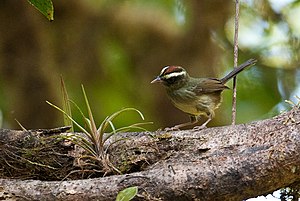Pirrewaldsinger
| Pirrewaldsinger | ||||||||||||
|---|---|---|---|---|---|---|---|---|---|---|---|---|

Pirrewald warbler ( Basileuterus ignotus ) |
||||||||||||
| Systematics | ||||||||||||
|
||||||||||||
| Scientific name | ||||||||||||
| Basileuterus ignotus | ||||||||||||
| Nelson , 1912 |
The Pirrewaldsänger ( Basileuterus ignotus ) is a small songbird from the genus Basileuterus in the family of the wood warbler (Parulidae). This species forms a super species with the black-cheeked wood warbler ( Basileuterus melanogenys ) . Some authors consider the pirrewald warbler and the black-cheeked warbler to be con- specific . The small distribution area is located in south-eastern Panama and Colombia . The IUCN lists the bird species as "endangered" (vulnerable).
features
Pirrewaldsänger reach a body length of 13 to 13.5 centimeters. Adults and young birds from the first year onwards have a reddish-brown skull, narrow black stripes on the crown of the head, which are connected to one another on the forehead, and wide, pale, greenish-yellow over-eye stripes , which are also connected to the forehead and extend down to the neck . The ear covers are olive and mottled black. The upper side plumage is olive green, the wings and the tail are dark brown with olive green feather edges and the lower side plumage is creamy-yellowish with washed out olive flanks and breast sides. The legs are yellowish flesh-colored, the beak is flesh-colored with a blackish beak ridge.
Occurrence, nutrition and reproduction
Pirrewald warblers are widespread in the mountains Alto de Nique and Cerro Tacarcuna in the province of Darién in Panama near the border with Colombia and in northwestern Chocó in Colombia. They inhabit mountain forests above 1200 meters and predominantly from an altitude of 1400 meters. Their food consists mainly of insects, which they find at heights of 2 to 10 meters in the middle and upper regions of the trees. During their forays they can usually be seen in pairs or in small groups. Sometimes they join other species of birds such as the black-cheeked bush tangar ( Chlorospingus inornatus ).
There are no studies on nest building or the breeding and nestling times. In July, adult birds were seen feeding young birds that had just fledged on Cerro Pirre Mountain in Darién.
swell
literature
- Jon Curson, David Quinn, David Beadle: New World Warblers. Helm, London 1994, ISBN 0-7136-3932-6 , pp. 88 and 223.
Web links
- Basileuterus ignotus in the endangered Red List species the IUCN 2010. Posted by: BirdLife International, 2009. Accessed March 20, 2011th
- Pirrewaldsänger at BirdLife International (online, accessed March 20, 2011)